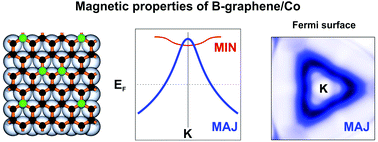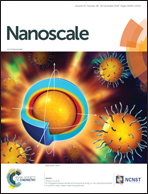Spin-polarized Fermi surface, hole-doping and band gap in graphene with boron impurities†
Abstract
Embedding foreign atoms in graphene and interchanging the underlying substrate are proved to be efficient methods for manipulating the properties of graphene. Combining ARPES experiments with DFT calculations we show that boron-doped graphene (B-graphene) grown on a Co(0001) substrate by chemical vapor deposition (CVD) becomes hole doped and its Fermi surface near the K-point reveals strongly spin-polarized states. The latter stems from the spin-polarized mini Dirac cone that is an intrinsic two-dimensional feature of the graphene/Co(0001) interface and is formed by a mixture of C 2pz and Co 3d states. Since the CVD method allows the achievement of up to 20 at% of incorporated B atoms, this provides a certain flexibility for handling the spin-polarized properties of the system. We also show that the bonding of the B-graphene layer to the Co(0001) substrate can be released by intercalation of Li into the interface. This allows the exploration of the doping effect in detail. Finally, our ARPES data indicate a gap opening in the Dirac cone as a result of the highly unbalanced boron concentrations in the two graphene sublattices.



 Please wait while we load your content...
Please wait while we load your content...